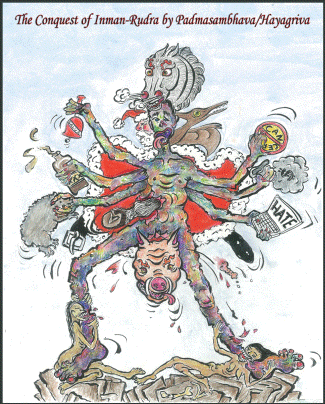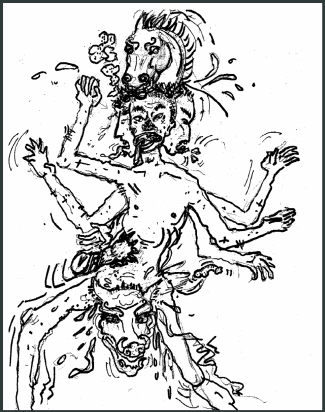|
Bulletin Board Pix
The Conquest of Inman-Rudra by Padmasambhava/Hayagriva




 First Draft of The Conquest of Inman-Rudra by Padmasambhava/Hayagriva
Rudra Who Ate His Mother
Excerpt from The Sherpas of Nepal in the Tibetan Cultural
Contest
by Robert A. Paul
© 1982 by the University of Chicago
The first real story in the Padma-thang-yig, after
introductory passages evoking various aspects of the
divinity and the cosmos, is that recounting the primordial
tale which, in a symbolic way, gives rise to the whole
subsequent set of events. It sets up an opposition between a
universal force for evil and its adversary, Padma himself.
In an earlier existence, Padma went to a country called "Du-ljongs-mts'ams
to make converts. He decided to convert to the Doctrine a
certain householder's son and his servant. He himself took
the form of a monk named Thub-bka-gzhon-nu, "Invincible
Youth." His disciples were Go'u-ku-dkris, "Kau universal
misery," the son; and the servant, Brahmadeva. The son, on
becoming Padma's disciple, took the religious name
Thar-pa-nag-po, "Black Deliverance"; the servant assumed the
religious name Ngan-phag, "Evil Pig."
Whereas Evil Pig understood and accepted the master's
teaching, Universal Misery, or Black Deliverance, failed to
see the value of a doctrine which preaches the vanity of
this world and nonattachment to all things. He therefore
banished his teacher and entered upon dissolute ways; he
seduced nuns, ate corpses, dressed in animal skins, and, in
the form of an ox, led his fellow animals into rapacious
practices.
Upon his death he underwent a great number of rebirths in
various noxious forms, such as a black jackal, a bee with a
painful sting, a worm, and so on. Finally he was born as the
son of a courtesan in Sri Lanka, fathered by three fierce
spirits of the evening, midnight, and dawn respectively. He
was born with three heads, six hands, and a horrible aspect.
His mother died nine months after his birth, and the people,
fearing this bastard of fatal augury, threw him into a
charnel ditch, home of the poisonous snakes of hate, the pig
of error, and the cock of desire.
For seven days he kept himself alive by sucking pus from the
breast of his mother's corpse. Then for a week he sucked her
blood, then ate the breast itself for a week, then the
viscera, then the flesh of her buttocks, then the marrow of
her bones, the rotten spinal fluid, and the brains. Having
grown big in forty-two days in this grisly way, he took the
skin of his mother's corpse for his tunic and the skull for
his libation cup.
This monster now proceeds to become a source of all evil and
terror; he destroys and eats wild beasts, his body exudes
every manner of illness, and so on. At the head of an
ever-growing army of malignant forces he threatens to
conquer the whole world, under the cognomen Rudra-who-ate-his-mother.
His army scores victory after victory, until the high gods
fear for the worst, seeing that:
If Rudra is not conquered by the power of the Buddha,
The Buddhist doctrine will not flourish, and he, rolling his
body to damnation,
With detestable works,
Will experience the weapons of Hell's tormentors (Toussaint,
1933, 3.
Knowing with divine omniscience the way in which Rudra can
be successfully challenged, the gods give the assignment to
Invincible Youth and Evil Pig. Receiving the benediction of
Pawa Cherenzi and Tara, master and disciple respectively
assume the guises of a Form-of-a-horse and Form-of-a-pig.
They manifest themselves in Malaya, and challenge Rudra by
performing nine impetuous dances. He responds with boasts
and threats of his own, and the battle is joined.
Then Form-of-a-horse (Sanskrit Hayagriva, Tibetan rTa-mgrin]
penetrated by the lower gate of Deliverance [Rudra]
And Rudra, crushed by the head of the horse which stood
erect
Stretched out his arms and legs.
At ease and in rich attire,
The horse's head, tinted with a variegated humor, became
green.
Form-of-a-pig slid himself into the little bhaga (vulva) and
lifted it with his head.
The head of the pig, tinted with a grease bath, became
black.
The faces of the horse, and pig embracing, their impurities
thick, augmented (ibid. 39)
His distended body in intolerable heat, Rudra cries out in
distress, "Father, Mother, Huyu!" In this rather
extraordinary manner, Rudra is overcome and converted to the
service of the Doctrine. Despite his temporary conversion,
however, he remains the symbol of the enemy of Buddhism,
with whom Padma must continually do battle.
David-Neel and Yongden (1959) recount a version of this
story which is the same in most respects, but includes a
certain detail which is particularly interesting from my
point of view. This is that, at the height of his powers,
Rudra became the lover of the cannibal queen of Sri Lanka.
But the avatar of Padma, in order to subdue Rudra, secretly
seduced this cannibal queen and sired a son by her.
Physically he [the son] exactly resembled Matamrudra [Rudra
who ate his mother], his supposed father, but it was the
spirit of Tampatogsken [the equivalent of Invincible Youth
in this version] that animated him. In the beginning, the
demon did not question the origin of the child and regarded
him as his own, but when the latter had grown up and the
monster perceived that his so-called son was trying to
dethrone him, he suspected the truth (ibid. 27).
In this version, it is the son who looks like Rudra but is
really Padma who, along with the good disciple, conquers
Rudra. Their method involves a slight variation on the
theme:
His former master transformed himself into a horse, entered
his body by the orifice of the rectum, and passing through
its whole length, came out at the top of the skull. At the
same time, Thaiphag [Evil Pig in this version] turned
himself into a boar, passed through the monster in the
opposite direction, entering at the top of the head and
issuing by the rectum (ibid.).
Return to Table of
Contents
|